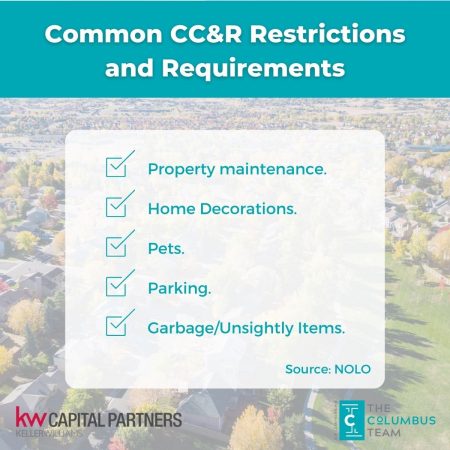
A Homeowner’s Association, or HOA, is a non-profit set up to maintain the common areas of your subdivision or condos. Your dues pay for the care of common areas, features, and buildings. Some HOAs also maintain a standard of appearance for homes within the association. This prevents an owner from making changes to his property that negatively affect the value or enjoyment of the other homes.
A Board of Directors runs the HOA, governed by bylaws. The list of covenants, conditions, and restrictions, or CC&Rs, are the rules that govern all the owners and tenants within the association. Monthly or annual fees are collected, and the HOAs rulings (including penalties assessed for non-compliance) have been upheld in courts. Most HOA’s can legally enforce the CC&Rs and the fee collection. There are usually penalties for non-compliance, up to and including a lien on your home, or a foreclosure. It’s very important to learn about the HOA that governs a neighborhood in which you’d like to purchase a home. It’s equally important to acquire and examine the CC&Rs for that HOA so that you can evaluate whether you’d be happy living within their rules.
10 Tips on Being a Happy HOA Member
DO

- Pay your dues. When you are paid up, and on time, you retain your voting rights in the HOA, and are a member in good standing, which can influence decisions on any petitions for variances you may make in the future.
- Read your CC&Rs carefully. When you’re not under pressure to make a home improvement or have spring fever over new landscaping, read through the rules for your HOA. Be familiar with the do’s and don’ts of your organization.
- Stay in the loop. Go to meetings, perhaps switch off with another neighbor to lessen the burden and keep each other informed. Keep an ear out for neighborhood news. The Jones family got a variance for a pool? The Smith’s were fined for not matching their shingles to the rest of the street? Keeping up with the neighbors’ interactions with your HOA board can give you an idea of where they stand on issues that might affect you later!
- Plan ahead. If you know you’re planning a change to the appearance of your home, or the use of your home, study up on the CC&Rs, and apply for a variance early. Preferably months in advance. It can take a month to hear an application, a month to debate, and another to rule. Then if you appeal, that can double the time. Tempers flare on both sides when time pressure kicks in, so set your sail for calm waters and easy going.
- Get along! It sounds simplistic, but keeping a friendly relationship going with your direct neighbors on all sides can be a blessing. If you’re cordial, life in the HOA is easier. Fred wants a fence? Well you’ve been wanting to put in a veggie garden. Why not support each other’s petitions. HOAs are far more likely to approve variances when all the parties on adjoining properties agree.
DON’TS
- Don’t hold payments. Pay up as you go through the process set up by the HOA board. If they fine you, even if they’re wrong, they can collect interest and further fines for non-payment. EVEN IF YOU’RE IN THE RIGHT. It’s far easier and less expensive to get your money back afterward than to pay interest and penalties accrued over months of wrangling.
- Don’t operate on hand-shake agreements. This is your home, probably your largest investment. Protect it and make sure you get your variance in writing or have the latest CC&Rs in writing before making any changes to the outside of your home. While one board member may assure you purple shutters are historical and lovely, don’t buy the paint until you have the variance in hand, in writing.
- Don’t get defensive. It’s unpleasant to be told you’re breaking the rules. Take a deep breath, check your CC&Rs, and stop and think. Your daughter made you a sculpted lawn ornament that has resulted in a warning. Only you can decide whether to apply for a variance or make it an indoor sculpture. But responding with an angry phone call or bitter complaints to neighbors will only make things worse.
- Don’t forget to use the CC&R to your advantage. When negotiating with services such as roofers, painters, and lawn care, let them know you’ve got HOA rules to honor. Make those rules a part of your contract for service. If the roofer doing repairs after storm damage has a contract saying only #3452 green shingles will do, then he must replace them at his cost if he uses the wrong color. That contract shows the HOA that the error isn’t yours, which may help you gain a little time to fix the problem.
- Don’t forget to vote. One of the most powerful tools an owner’ has is the vote. Members of the HOA can vote in elections for Directors, and on matters of policy according to the bylaws. So attend meetings, offer to get involved, and stay aware of the news from the neighborhood. HOAs must have a copy of their current bylaws on file. That will make it easier to get a copy of the bylaws, so you can see when and how to vote.
Most of all, relax and enjoy your home and your neighborhood. Your HOA is dedicated to maintaining the value and beauty of the whole neighborhood, and that’s part of what you love about your home. Appreciate the manicured common areas, and have confidence that you’ll never wake up some Sunday morning to discover cars on blocks across the street and a purple house next door. Enjoy the peace of mind of living in a community with an active HOA!





